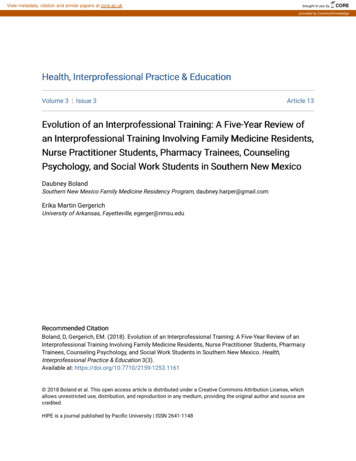
Transcription
(This is a sample cover image for this issue. The actual cover is not yet available at this time.)This article appeared in a journal published by Elsevier. The attachedcopy is furnished to the author for internal non-commercial researchand education use, including for instruction at the author'sinstitution and sharing with colleagues.Other uses, including reproduction and distribution, or selling orlicensing copies, or posting to personal, institutional or third partywebsites are prohibited.In most cases authors are permitted to post their version of thearticle (e.g. in Word or Tex form) to their personal website orinstitutional repository. Authors requiring further informationregarding Elsevier's archiving and manuscript policies areencouraged to visit:http://www.elsevier.com/authorsrights
Author's Personal CopyJournal of Interprofessional Education & Practice 10 (2018) 67e75Contents lists available at ScienceDirectJournal of Interprofessional Education & Practicejournal homepage: http://www.jieponline.comSocial work: Integral to interprofessional education and integratedpracticeLisa de Saxe Zerden*, Brianna M. Lombardi, Mark W. Fraser, Anne Jones,Yazmin Garcia RicoSchool of Social Work, University of North Carolina, Chapel Hill, NC, United Statesa r t i c l e i n f oa b s t r a c tArticle history:Received 14 July 2017Received in revised form19 December 2017Accepted 26 December 2017Although the debate on US health care reform is ongoing, existing policy has expanded access to preventative and treatment services through new models of integrated care. This has resulted in the creationof interprofessional healthcare teams comprised in part of social workers who undertake brief behavioralhealth intervention, care management, and service referral. To promote patient care and populationhealth, integrating social workers onto interprofessional teams requires educating all members of thehealthcare team on the roles and functions of social workers. A case vignette is included to demonstratehow interprofessional teams can use the skills of social workers to offer brief, evidence-supported interventions and inform team-based care. Suggestions are offered for moving forward to increase theparticipation of social work in IPE and practice settings. 2017 Elsevier Inc. All rights reserved.Keywords:Social workSocial workersIntegrated careIntegrated behavioral healthInterprofessional teamsImproving clinical and population health outcomes often focuses on system-wide changes viewed as part of an evolving, if notradically changing, landscape in health care.1,2 Much of the discussion related to improving outcomes has centered on the needfor implementing new models of care. Specifically, the disease/diagnosis model would be replaced with an integrated model ofcare that includes early intervention (ie, prevention) as well as thecoordinated treatment of physical and behavioral health problems.This transition is conceptualized as moving from sick care to healthcare3 and replacing the physician-centric model with a patientcentric, team-based model of care. The move toward a teambased approach in health care is supported by research evidencesuggesting that providing primary care through interprofessionalteams not only improves the quality, safety, and efficiency of services, but also increases use of available services.4e6 Nevertheless,health systems have been slow to adopt team-based practice, andthis innovative practice approach continues to face implementationchallenges.4,7,8Increasing the uptake of interprofessional teams in health caresystems is a complex challenge because doing so requires changesat the practice and administrative levels, as well as changes ineducation and training for practice. Educational approaches need to* Corresponding author.E-mail address: Lzerden@email.unc.edu (L. de Saxe 2405-4526/ 2017 Elsevier Inc. All rights reserved.align preparation for professional practice with health care reform.9Across health care professions, interprofessional education (IPE)is becoming an integral element of preparation for practice.10,11Defined by the World Health Organization,12,p.196 IPE occurs when“students from two or more professions learn about, from and witheach other to enable effective collaboration and improve healthoutcomes.” The goal of IPE is to prepare future health providerswith the knowledge, skills, and attitudes necessary to embraceteam based care. That is, IPE is intended to prepare practitioners towork collaboratively as partners on interprofessional teams. Acrossdisciplines and professions, IPE prepares students to problem-solveinterprofessionally, think as a team member, and ultimately, understand and appreciate the contributions of each profession toclinical outcomes and population health.10Models of IPE were developed and pioneered in nursing andmedicine.13,14 In contrast, the social work profession has been latein embracing IPE and interprofessional practice despite the profession's historical involvement in health care.15,16 The Council onSocial Work Education17 (CSWE; the accrediting body of social workeducation in North America) only recently became a member of theInterprofessional Education Collaborative (IPEC), a national association for schools in the health professions. IPEC was formed “topromote and encourage constituent efforts that would advancesubstantive interprofessional learning experiences to help preparefuture health professionals for enhanced team-based care of
Author's Personal Copy68L. de Saxe Zerden et al. / Journal of Interprofessional Education & Practice 10 (2018) 67e75patients and improved population health outcomes.”18,p.1 Althoughthe debate on US health care reform is ongoing, recent policies haveexpanded insurance coverage and increased access to preventativeand treatment services through new models of integrated care.19This expansion has significant implications for the way in whichsocial work is practiced as well as the potential contribution ofsocial work on interprofessional health care teams.The purpose of this article is to further articulate the roles andfunctions of social workers in integrated health care systems and tobriefly review evidence for the inclusion of social workers oninterprofessional integrated treatment teams. Moreover, for healthprofessionals outside of social work, this article describes the skillsthat social workers bring to integrated health care settings. Weoutline the functions fulfilled by social workers in promoting patient care and population health. We have included a case vignetteto demonstrate how a social worker, as a member of an interprofessional team, might use brief, evidence-supported interventionsin an integrated health care setting. In addition, we identify theroles of social workers in contributing to a patient's plan of care thataddress both physical and behavioral health, including the socialdeterminants of health. Further, suggestions are offered for movingforward to increase the participation of social work in IPE andpractice settings.1. Social work in health careSocial workers fulfill a crucial role in addressing the modifiabledeterminants of health20,21 dor the social determinants of healthwherein social and environmental factors that affect physical andbehavioral health outcomes are considered.22 Social workers withgraduate training are well equipped to apply a person-inenvironment perspective and to recognize the full array of biopsychosocial factors that influence the health status of patients.20,21,23 Health care reforms require a holistic approachbecause both physical and behavioral health are influenced by riskand protective factors that include biological and social influences.The involvement of social work in addressing the social determinants of health is not new. A century ago, health scholarsunderstood that physical health was fundamentally linked to thesocial environment and wrote about the potential of social work tocontribute to better health.15,16 These scholars argued that the social environment frequently delimited the capacity of patients toaccess care and subsequently respond to treatment. Although, ascompared with the social work case descriptions that dominatedthe literature in the early 20th century, current perspectives onsocial work in health care are based on more systematic research;however, the conclusions are much the same. This new literature iscompelling: “A population's health is shaped 10% by the physicalenvironment, 20% by clinical health care (access and quality), 30%by health care behaviors (themselves largely determined by socialand physical environments), and 40% by social and economic factors.”24,p.4,25 Link and Phelan's seminal work “Social Conditions asFundamental Causes of Disease” largely attributed suboptimal healthoutcomes to social factors, including education, income, employment, and neighborhood or housing conditions.26Social workers constitute the largest group of providers ofbehavioral health services in the United States.27 Historically,behavioral health services have not been integrated with healthcare systems; therefore, it is not surprising that IPE and the socialwork role in integrated care settings have not been incorporatedinto social work curricula. However, recent funding by US federalagencies has created new opportunities for schools of social work toengage in interprofessional training. For example, in 2014, theHealth Resources Service Administration (HRSA) awarded morethan 26 million to 62 social work programs around the country tofund pilot programs designed to train and expand the behavioralhealth workforce.28 These awards were targeted to masters of social work (MSW) programs and MSW students doing direct practicework in integrated health care settings. Additionally, 54.6 millionwas awarded to community health centers to hire mental healthprofessionals, with the aim of increasing access to communitybased mental health services.29 Because this funding was basedon the recognition that social and environmental factors contributeto both population health outcomes and national costs for healthcare, this level of funding reflects an important re-alignment in theprovision of health care services across the United States. Moreover,these funding streams were established with the intent of reducingfragmentation and “siloed” approaches to the delivery of physicaland behavioral health care. These initiatives emphasize thecollaborative delivery of physical and behavioral health care in onesetting and through the creation of an individualized plan of caredeveloped for each patient by an interprofessional team.302. Models of integrated care and emerging roles for socialworkThe term integrated health care, often referred to as interprofessional health care, refers to the coordination of care that involvesboth physical and behavioral health services to address the wholeperson.31 However, other definitions of integrated care considerintegration more broadly. For example, Kodner and Spreeuwenberg32.p3defined integration as “a coherent set of methods andmodels on the funding, administrative, organizational, service delivery and clinical levels designed to create connectivity, alignment,and collaboration within and between the cure and care sectors.”These multi-tiered approaches synchronize treatment across multiple providers for the assessment, treatment, and follow-up ofmultiple health conditions affecting patients. The resultingcomprehensive set of services is organized through a single, unifiedplan of care to which each member of an interprofessional teamcontributes.33,34 As members of interprofessional care teams, socialworkers are increasingly hired to work in primary care settingswhere they provide screenings, assessments, brief interventions,care management, crisis intervention, and prevention interventions to address behavioral health problems and the socialdeterminants of health.21,35e37The precise structure of integrated care and the interorganizational processes associated with this practice approachtend to be setting dependent. That is, models of integration mightlook different from setting to setting, as health care entitiescontingently develop mechanisms to meet the unique needs ofdiverse patient populations, health systems, and communities.Although the research on the provision of integrated care is mixed,several models of care have empirical support.35,38e42 Perhaps, the2 most commonly studied models of integrated care are the chroniccare model (CCM) and the collaborative care model. The CCM wasdeveloped to treat individuals with complex, co-morbid, and unstable physical health conditions.42 The CCM uses a care manager toregularly track patient health and relay that information to a teamof providers who ensure a rapid, coordinated response. CCM caremanagers also work to meet the psychosocial needs of patients tostabilize non-medical factors that disrupt treatment complianceand compromise patient health. Like the CCM, the collaborativecare model includes a multidisciplinary provider teamdtypically aprimary care provider, a care manager, and a consulting psychiatristdworking together on a patient treatment plan.43e45 Whereasthe CCM focuses on unstable medical conditions, the collaborativecare model focuses on the assessment and treatment of behavioralhealth conditions, most commonly within primary caresettings.43e45
Author's Personal CopyL. de Saxe Zerden et al. / Journal of Interprofessional Education & Practice 10 (2018) 67e75693. Key features of team-based care5.1. Screening and assessmentTeam-based care is considered crucial for addressing patienthealth needs. However, the design and management of team-basedcare is complex. Wohler and Liaw46,p2 observed, “the study andimplementation of team-based primary care has been complicatedby the flexible nature of teams in primary care.” Studies of interprofessional care rarely “dismantle” the unique contributions ofprofessions to patient outcomes in integrated care research.Instead, outcomes are attributed to the interventions providedcollectively by members of interprofessional teams. Hence, it isdifficult to parse out the individual contributions of physicians,nurses, social workers, and other allied health professionals.However, recent systematic reviews suggest interprofessionalteams comprised in part of social workers produced positivepatient-level health outcomes.37As health systems move toward metrics-based health care, newemphasis is being given to understanding measurement and usingstandardized assessment tools as a basis for practice.48,49 Socialworkers are actively involved in screening and assessment in integrated care settings. Screening is the process of identifying aproblem (ie, the presence or absence of a health condition),whereas assessment is the process of determining the nature of aproblem, including whether the problem meets diagnostic criteria,developing treatment recommendations, and specifying social andenvironmental factors that have the potential to disrupt treatmentrecommendations.50 Across integrated settings, social workers usea variety of screening and assessment tools to identify problems,including behavioral health issues such as substance use disorders(SUD), depression, and anxiety. Examples of the screening andassessment tools typically used by social workers in integratedhealth settings include the Alcohol Use Disorders IdentificationTest,51 Drug Abuse Screening Test,52 the Generalized Anxiety Disorder-7,53 and the Patient Health Questionnaire-9.544. Evidence for social work integration on interprofessionalteamsSocial workers have a diverse set of skills that can contributesubstantially to the efficacy and efficiency of interprofessional careteams. Depending on a social worker's training and licensure, aswell as the needs of the patient and team, these skills can rangefrom providing evidence-informed interventions for behavioralhealth problems (eg, depression, anxiety), to coordinating servicesprovided by the care team members, to linking patients withcommunity services (eg, transportation for appointments). A systematic review conducted by Fraser et al.,37 identified 26 randomized trials that used a social worker as part of theinterprofessional treatment team in integrated primary care settings. Compared with routine services, care delivered by an interprofessional care team comprised in part of social workersproduced positive significant patient-level outcomes in 19 of the 26studies, with the largest effect sizes seen for the treatment ofdepression and anxiety.37 Similarly, Steketee47 et al. (2018) conducted a systematic review of social worker-involved health services interventions in 15 identified studies that reported on bothhealth and cost outcomes.5. How do social workers contribute to interprofessionalteams?Social workers fulfill many roles in healthcare systems (eg, carecoordination, discharge planning, behavioral health treatment,prevention intervention). However, social workers typicallycontribute to interprofessional teams through 3 primary roles. TheFraser et al.37 systematic review suggests the functions of socialworkers in health care settings fall into 3 domains or roles: (1)provision of behavioral health interventions; (2) management ofcare, especially for older adults and patients with chronic conditions; and (3) engagement with social service agencies on behalf ofpatients. Each of these roles aligns with different sets of skills andthe combination of the 3 roles defines the potential contribution ofthe social worker on the interprofessional team. Indeed, some social workers might fulfill all 3 roles within their teams, whereassocial workers in specialized settings might fulfill only 1 or 2 roles.This variation, or flexibility, in the roles fulfilled by social workers isprecisely the reason for much of the confusion regarding the potential contributions of social work on interprofessional teams. Thescope of social work education and the functions of social work oninterprofessional teams require better calibration. To furtherdescribe the skills that social workers bring to integrated teamsacross these 3 roles, the following section outlines the specificcontributions social workers make to integrated care teams.5.2. Brief substance-use interventionsThe variety of psychosocial treatments that social workers candeliver to treat substance-use conditions include cognitivebehavioral therapy (CBT), contingency management, the community reinforcement approach, motivational interviewing (MI), andmotivational enhancement therapies.50 Social workers regularlyuse brief evidence-supported interventions as a part of plan of careactivities related to SUD. In primary care settings, brief interventions might last from a few minutes to an hour or more.Aimed at interrupting the cascade of negative individual and societal effects associated with SUD,55 these interventions can beprovided by MSW-prepared social workers in integrated healthcare given their expertise and clinical training.56 One of theemerging challenges remains how to best integrate SUD preventionand treatment interventions into integrated primary care settings.Use of tobacco products, for example, is a well-known predictorof health outcomes, and, brief interventions for smoking cessationprovided by social workers in primary care settings have beenshown effective.38,57,58 Although primary care physicians screen fortobacco use, physicians' time with patients is usually too limited toprovide an actual intervention.59 A randomized controlled trial(RCT) of 943 smokers with military-related PTSD recruited from anoutpatient clinic at 10 Veterans Affairs medical centers and followed up for 18e48 months integrated a tobacco cessation program into typical behavioral health care using social workers andpsychologists.57 Compared with a non-integrated smoking cessation program, the integrated program was effective in producing aprolonged abstinence of tobacco as measured by both self-reportand bio-verified measures. Similarly, social workers have demonstrated success in using brief MI-related interventions (15e20 min)in primary care settings with teenagers at risk for substance use;these brief interventions take place within the context of a scheduled appointment for other primary care services.38,58 Althoughrandomized, these pilot studies involved small sample sizes andwarrant further work based on larger and more diverse samples.5.3. Brief mental health interventionsClinical social workersdthose who have a MSW degree and arelicensed to provide direct mental health servicesdpossess thetraining and skills necessary to perform brief mental health interventions in integrated care settings.56 Licensed social workersare trained, for example, to provide brief CBT, which typically lasts
Author's Personal Copy70L. de Saxe Zerden et al. / Journal of Interprofessional Education & Practice 10 (2018) 67e75between 4 and 8 sessions and can be implemented in integratedcare settings such as primary care clinics.60,61 Sometimes calledbrief CBT (B-CBT), this approach uses a condensed version of CBTadapted for use in settings where clinicians have limited time forpatient contact.62 B-CBT focuses in part on cognitions that elevaterisk (eg, thoughts of hopelessness or helplessness). B-CBT has beenshown effective in reducing symptoms of depression and anxiety inpatients with chronic health conditions,63 older adults,64 adolescents,65 and veterans.66 Additionally, B-CBT can be used in a groupformat providing flexibility in the primary care setting.67Problem-solving therapy (PST) is also supported with growingempirical evidence and is a therapeutic modality commonly taughtin MSW programs.60,61,68 PST has been shown effective in primarycare settings, where it is often called problem-solving therapydprimary care (PST-PC).69 PST-PC interventions are educationalin nature and use an intervention approach in which patients learnto breakdown problems into smaller, more manageable units.Working with a social worker, patients identify and evaluate potential solutions for each unit or issue. PST-PC relies on the clinicalskills routinely taught in MSW education. These skills emphasizestarting “where the client is,” and are founded on a core value ofclient/patient self-determination.70 For example, a study comparedusual care to PST-PC for older adults (N ¼ 433) with depression ordysthymia in primary care settings delivered through collaborativecare via a depression care specialist comprised of a social worker ornurse and a medical provider.71 Findings demonstrated that olderadults who received PST-PC through collaborative means had moredepression-free days in 1 and 2 years post intervention and fewerdepressive symptoms 12 months post intervention.Similar to PST-PC, social workers in integrated settings often usepsychoeducation in combination with other brief mental healthinterventions. Psychoeducationdsometimes called patient orconsumer educationdis used to increase knowledge, information,and support for patients and their families. It has a strong foundation of research evidence from decades of testing.72,73 As thename implies, psychoeducation provides patients with informationon their health diagnoses. Personalized and more prescriptive thanthe brochures and written materials that are ubiquitous in clinicsand pharmacies, psychoeducation often “normalizes” concern forhealth problemsdboth physical and behavioraldand begins theprocess of learning ways to manage symptoms. Psychoeducationinterventions can be applied across settings and adapted to servepatients with a range of medical and behavioral health needs.73MI is commonly used to engage patients in treatment and isoften used in conjunction with other forms of behavioral healthinterventions.74e76 One example of using MI to engage patients inbehavioral health treatment was a trial of Brief Interpersonal Psychotherapy for perinatal depression provided in an OBGYNsetting.77 By delivering an initial engagement interview that usedMI, Grote et al.78 found a significant increase in participation intreatment compared to participants who received no engagementinterview. MI can be applied to a variety of populations includingadolescents, adults, and families and has been used by socialworkers in primary care settings to facilitate treatment engagement and promote referral to needed resources.76,79 MI is sometimes used as a primary intervention. For example, in a randomizedtrial at an infectious disease clinic, Golin et al.80 used MI as anelement of safe-sex counseling for people living with HIV/AIDS.Provided by MSWs, the intervention involved 3 consecutivemonthly sessions intended to help motivate patients towards safersexual practices. Compared with a counseling program that includes adapted nutrition and physical activity, the results indicatedthat the MI-based intervention program significantly increasedpatients' motivation to change behaviors.80Finally, mindfulness interventions, which blend Easternmeditation approaches with Western medicine and cognitivepsychology, have shown promise in primary care settings.81,82 Acomprehensive meta-analysis of 209 studies enrolling 12,145 participants assessed the evidence of mindfulness-based therapies forpatients with comorbid physical and behavioral health problems.81For example, in an RCT of adults with chronic pain and prescriptionopioid misuse (N ¼ 115), clinical social workers delivered an 8week mindfulness oriented intervention.83 Preliminary findingsfrom this RCT indicate that as compared with participants in asupport group, participants who received the mindfulness-orientedintervention reported significantly greater reductions in painseverity, stress arousal, and self-reported desire for opioids at 3months post intervention.836. Social work care managementIn addition to the provision of behavioral health interventions,social workers also often participate in care management activitieson integrated care treatment teams.21,37 The deployment of caremanagers has expanded in integrated care settings towardensuring the quality of care and promoting cost efficiency. Caremanagers are often responsible for continued assessment ofsymptoms, facilitation of treatment goals, and coordination ofservices.21 In addition, care managers provide individual and familyeducation about health and behavioral health diagnoses as well asassist in linking patients to community services. The extensivetraining of MSW-level social workers to identify psychosocial factors that affect the uptake of health services make social workerseffective care managers, especially for patients suffering fromchronic conditions that are associated with difficult social situations.84e86 Curricula to train social workers to fulfill care management roles is rapidly growing in the United States, and CSWEhas developed course standards for core competencies in caremanagement.7. Behavioral health plus care manager role: an emergingpractice model for social workThe skills of MSW social workers allow them to fulfill severalroles on integrated care teams. The configuration of their roles andfunctions is dependent on patient needs and, often related tosetting conditions and constraints, the aggregate skillset of theinterprofessional team. A series of recent RCTs has deployed socialworkers as behavioral health specialist-care managers.85,87 Forexample, in Ell et al.’s87 work in a safety-net community, clinicalsocial workers participated in a multifaceted diabetes and depression program as diabetes-depression clinical specialists. Socialworkers provided problem-solving therapy and relapse preventionthrough monthly patient check-ins that included monitoringsymptoms and the social determinants of health for 387 lowincome patients, of whom 96% were Latino. Study participants reported significant reductions in depression and improved functioning at 18 months.87 In another test of this model, social workersfulfilled a hybrid role serving on a collaborative care team at anOBGYN clinic working with disadvantaged women in a multisiteRCT trial with masked outcome assessment conducted in theSeattle-King County Public Health System.39 In this RCT (N ¼ 168),social workers served as depression care specialists and providedengagement services, interpersonal psychotherapy, and treatmentcare management on a multidisciplinary team. The collaborativecare treatment model produced significant reductions in depression scores and increases in behavioral health service utilization.39
Author's Personal CopyL. de Saxe Zerden et al. / Journal of Interprofessional Education & Practice 10 (2018) 67e758. Case example: social work in the behavioral health-caremanager roleThe following case study demonstrates the behavioral healthcare manager role in integrated primary care settings. This casestudy illustrates how the use of brief interventions, combined withcare coordination, community referrals, and team-based communication, results in care that addresses physical and behavioralhealth, including the social determinants of health. The case studyalso demonstrates the early identification of behavioral problemssuch as alcohol use, and, consistent with research findings, it showsthe potential of prevention interventions in interrupting thedevelopment of behavioral health problems into long-term debilitating and costly conditions.Exemplar case: role of social workers in an integratedhealth care settingMaria is a 17-year-old, mildly obese Latina high-schoolstudent in Burlington, North Carolina. Following complaints of increased fatigue, Maria was seen at a universityprimary care clinic for a re-check of her type 2 diabetes.While the team's physician was reviewing the symptomswith the patient, Maria acknowledged some alcohol use,non-compliance with medication, and feelings of anxiety.After ordering additional lab work, the physician gave Mariaa “sof
health intervention, care management, and service referral. To promote patient care and population health, integrating social workers onto interprofessional teams requires educating all members of the healthcare team on the roles and functions of social workers. A case vignette is included to demonstrate










